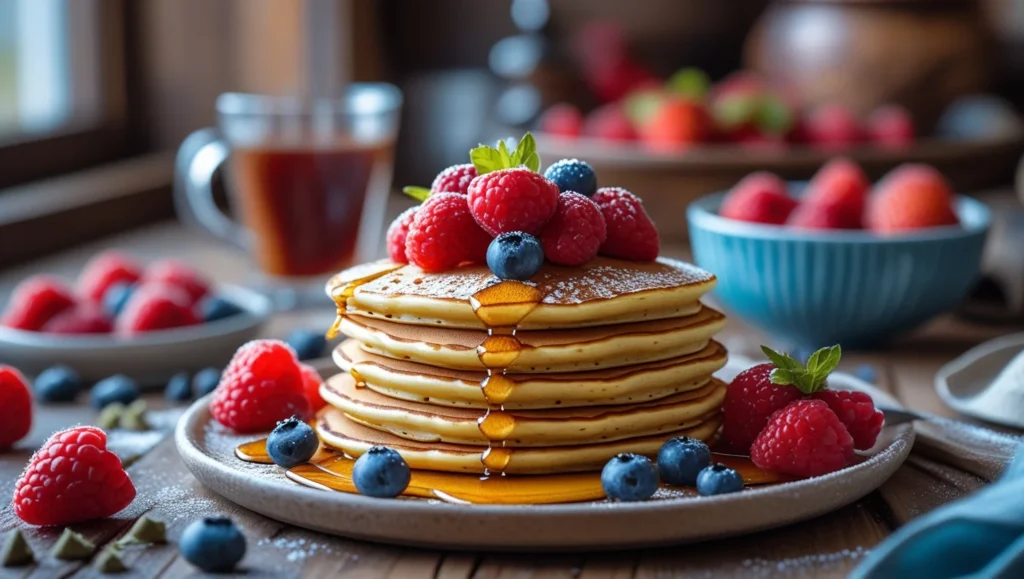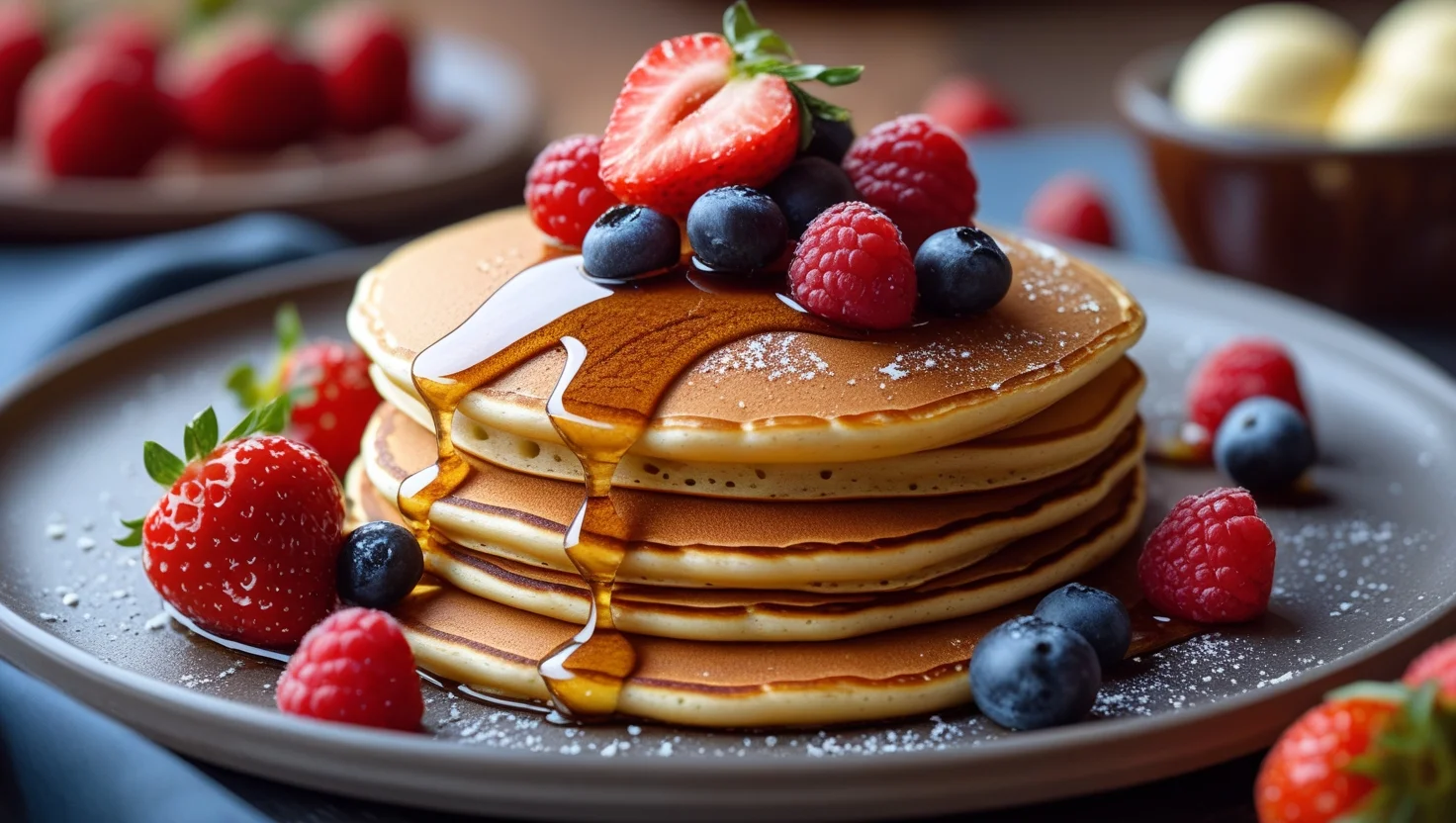Table of Contents
Everyday pancakes are the ultimate breakfast delight—simple, fluffy, and endlessly versatile. Loved by families worldwide, these pancakes are quick to make and perfect for busy mornings or relaxed weekend brunches. Whether you’re mastering a classic recipe or experimenting with creative variations, this guide will help you create the perfect stack of everyday pancakes every time.
What Are Everyday Pancakes?
The term everyday pancakes captures recipes designed for ease, versatility, and accessibility. These are not the overly elaborate recipes reserved for special occasions. Instead, they are the pancakes we rely on for quick breakfasts and relaxed weekend mornings.
Pancakes Through History
Did you know that pancakes have been a part of human cuisine for thousands of years? These versatile and beloved flatcakes have roots that stretch back to ancient civilizations. Archaeological evidence suggests that early forms of pancakes were made as far back as prehistoric times, using simple combinations of ground grains and water cooked over hot stones.
In medieval Europe, pancakes began to resemble the versions we know today, made with basic ingredients like flour, milk, and eggs. They became a staple food, often eaten during religious observances such as Shrove Tuesday, when households used up rich ingredients before the Lenten fasting period.
Cultures worldwide have put their unique spin on pancakes. In France, they became thin and delicate crêpes, while in Russia, fluffy blini were traditionally served with caviar or sour cream. Across Asia, pancakes take the form of savory options like scallion pancakes or sweet variations like Japanese dorayaki.
Today, pancakes continue to evolve, with modern renditions including gluten-free, vegan, and protein-packed options. Despite the many variations, the essence of pancakes remains the same: a comforting, adaptable dish enjoyed by people of all ages and backgrounds.
If you’re curious about the history and evolution of this timeless food, explore the history of pancakes to uncover the stories behind their enduring popularity.

Classic Recipe for Everyday Pancakes
Ingredients
To make the perfect batch of pancakes, you’ll need the following:
- 1 ½ cups all-purpose flour (substitute with almond or oat flour for healthier options)
- 3 ½ teaspoons baking powder (ensure it’s fresh for optimal fluffiness)
- 1 teaspoon salt
- 1 tablespoon sugar (or a natural sweetener like honey or maple syrup)
- 1 ¼ cups milk (use plant-based milk for dairy-free alternatives)
- 1 large egg (or flaxseed egg for a vegan option)
- 3 tablespoons melted butter (or neutral oil like canola or coconut oil)
Instructions
- Mix Dry Ingredients: Start by whisking together the flour, baking powder, salt, and sugar in a large mixing bowl.
- Incorporate Wet Ingredients: Gradually add milk, egg, and melted butter to the dry mixture. Stir gently until combined, but don’t overmix—small lumps are fine.
- Cook the Pancakes: Heat a non-stick skillet over medium-low heat. Lightly grease it with butter or oil. Pour about ¼ cup of batter onto the skillet for each pancake. Cook until bubbles form on the surface, then flip and cook until golden brown on both sides.
Using quality tools can make all the difference. If you need help choosing the right equipment, check out the best non-stick pans for pancakes for recommendations.
Secrets to Perfect Everyday Pancakes
Creating consistently fluffy pancakes requires attention to both technique and ingredient quality. Follow these tips for success:
1. Balance the Batter
- Avoid Overmixing: Stirring the batter too much develops gluten, leading to dense pancakes. Combine the ingredients just until they come together.
- Let It Rest: Allow the batter to sit for 5–10 minutes before cooking. This resting period ensures the flour hydrates and air bubbles form, which will make your pancakes light and airy.
2. Control the Heat
- Preheat Properly: A properly heated pan is crucial for evenly cooked pancakes. Medium-low heat works best to avoid burning or undercooking.
- Test the Pan: Sprinkle a few drops of water on the skillet; if they sizzle and evaporate quickly, the pan is ready.
3. Use Fresh Ingredients
- Fresh Baking Powder: Old leavening agents won’t provide the same rise, resulting in flat pancakes. Replace baking powder every six months for optimal results.
- Dairy Matters: High-quality milk or rich dairy substitutes contribute to better flavor and texture.
Creative Pancake Variations
Pancakes are a blank canvas, allowing you to experiment with a wide variety of flavors and styles. Why stick to just one recipe? Try these variations:
Sweet Variations
- Blueberry Delight: Add fresh or frozen blueberries to the batter. Serve with a dollop of whipped cream and a drizzle of maple syrup.
- Chocolate Lovers’ Pancakes: Mix in cocoa powder or chocolate chips for a decadent treat. Top with powdered sugar or chocolate sauce.
- Banana and Nut Pancakes: Mash ripe bananas into the batter and sprinkle crushed nuts on top before serving.
Savory Options
- Cheese and Herb Pancakes: Fold in grated cheddar and fresh herbs like chives or parsley. These are great as a side dish for soups or salads.
- Spicy Pancakes: Add diced jalapeños and a pinch of smoked paprika for a bold, savory kick.
- Vegetable-Infused Pancakes: Incorporate grated zucchini, carrots, or spinach for a nutrient-packed meal.
Health-Conscious Options
- Whole Wheat Pancakes: Replace all-purpose flour with whole wheat or spelt flour for extra fiber.
- Low-Sugar Alternatives: Sweeten the batter naturally with honey or agave syrup instead of refined sugar.
- Protein Pancakes: Mix in a scoop of protein powder or Greek yogurt for a more filling option.
Toppings and Pairings
Pancakes are as versatile in their toppings as they are in their recipes. Depending on your mood, you can make them sweet, savory, or somewhere in between:
Sweet Toppings
- Traditional maple syrup, honey, or fruit compotes.
- Fresh fruit like strawberries, bananas, or blueberries.
- Whipped cream, powdered sugar, or a drizzle of chocolate.
Savory Toppings
- Cream cheese, smoked salmon, or avocado spread.
- Fried or poached eggs, sautéed vegetables, or crispy bacon.
- Herb-infused butter or grated Parmesan.
Perfect Pairings
- Pair pancakes with sides like scrambled eggs, hash browns, or sausage for a complete breakfast.
- For drinks, consider a freshly brewed cup of coffee, a smoothie, or a glass of fresh orange juice.
FQAs
What are 3 random facts about pancakes?
- The world’s largest pancake measured over 49 feet in diameter and weighed nearly 3 tons!
- Pancakes are one of the oldest prepared foods, with evidence of early versions dating back to 30,000 years ago during the Stone Age.
- In some cultures, pancakes are a traditional food for Shrove Tuesday, also known as “Pancake Day,” which marks the start of Lent.
How long can pancakes sit out?
Pancakes can sit out at room temperature for about 2 hours. After that, they should be refrigerated to prevent spoilage. If left out for longer, especially in warm environments, they can attract bacteria and become unsafe to eat.
What is the secret to good pancakes?
The secret to great pancakes lies in:
- Not overmixing the batter, as this keeps them light and fluffy.
- Using fresh ingredients, especially leavening agents like baking powder.
- Cooking at the right temperature, ensuring an evenly browned, fluffy pancake.
What ingredient keeps pancakes from falling apart?
Eggs are the key ingredient that binds pancake batter together. If you’re making egg-free pancakes, substitutes like mashed bananas, applesauce, or flaxseed can provide the same binding effect.
What were pancakes originally called?
Historically, pancakes had various names depending on the region and time period. In early English history, they were called “hoecakes” or “griddlecakes,” while in medieval Europe, they were often referred to as “flapjacks.”
What is 3 pancakes called?
A stack of 3 pancakes is often simply referred to as a short stack, particularly in restaurants. Larger portions with 5 or more pancakes may be called a full stack.
What are pancakes known for?
Pancakes are known for their versatility and comforting texture. They are beloved for their ability to pair with both sweet and savory toppings, making them a universally appealing dish. Additionally, pancakes are symbolic of celebration and tradition, appearing in everything from holiday meals to casual breakfast spreads.
Troubleshooting Pancake Problems
Even with the best recipe, issues can arise. Here’s how to troubleshoot common pancake problems:
- Bitter Flavor: Too much baking powder or expired ingredients may be the culprit. Always measure carefully and use fresh supplies.
- Sticky Pancakes: If pancakes stick to the pan, ensure the skillet is properly preheated and greased before adding batter.
- Uneven Cooking: Thick batter or inconsistent heat can result in unevenly cooked pancakes. Thin the batter slightly or adjust the heat level for uniform results.
Pancakes as a Tradition
Making pancakes often becomes a cherished family tradition. Whether it’s flipping them together on a lazy Sunday morning or experimenting with creative toppings, pancakes have a way of bringing joy and connection to the table. These traditions, passed down from one generation to the next, make the simple act of cooking feel extraordinary.
Conclusion
Everyday pancakes are more than a simple breakfast—they’re a timeless comfort food that transcends cultures and generations. Their universal appeal lies in their versatility, ease of preparation, and endless potential for customization. Whether you prefer a classic stack with maple syrup or enjoy experimenting with bold flavors like savory herb pancakes or sweet chocolate chip variations, pancakes offer something for everyone.
Moreover, pancakes have the unique ability to bring people together. They’re often at the center of family traditions, weekend brunches, and leisurely mornings. The joy of flipping a perfectly golden pancake or adding your favorite toppings is as much about the experience as it is about the meal itself.
Additionally, their adaptability makes them a go-to choice for various dietary preferences. From gluten-free flours to vegan substitutes, everyday pancakes can cater to any lifestyle without compromising on taste or texture.
So why not make pancakes part of your daily routine? With the tips, techniques, and recipes shared here, you’re equipped to whip up pancakes that are not only delicious but also uniquely yours. Let each stack be a celebration of creativity, comfort, and culinary adventure—one pancake at a time.


11 thoughts on “Master the Art of Everyday Pancakes: Tips, Recipes, and Delicious Variations”